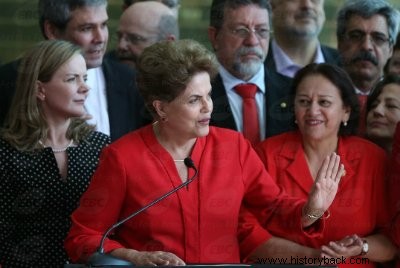The impeachment of Dilma Rousseff took place in August 2016.
Dilma was removed by the Senate on charges of a crime of fiscal responsibility.
Origin
The authors of the request for the removal of Dilma Rousseff alleged that she made up the public accounts and disrespected the budget law during the electoral campaign. The objective would be to give a false sense of security to the economy and guarantee re-election in 2014.
The maneuvers were dubbed "fiscal pedaling" in an allusion to the politician's preferred physical activity. She used to ride her bike in her spare time. And the word "pedal" used in a vulgar way means "to deceive".
In the first legislature, which began in 2011, Dilma relied on the positive legacy of former president Luiz Inácio Lula da Silva to govern. In the course of her government, the country was hit by an economic crisis that also affected other markets.

Pronouncement of Dilma after being removed from the Presidency
Despite the population's apprehension about the economy, Dilma won the elections in the second round against Aécio Neves, from the PSDB (Partido da Social Democracia Brasileira). Once again, Temer was kept as vice on the ticket, which had 51.64% of the votes against 48.26% of the opposition.
The poll results were questioned and divided the country.
Dilma Rousseff's main voters were in the Northeast. The region is historically the poorest in Brazil and received the largest share of social programs. For the opposition, the programs were used to garner votes and ensure the Workers' Party remains in power.
At the beginning of the second government, Dilma received pressure from the then president of the Chamber of Deputies, Eduardo Cunha, from the PMDB. Cunha was government leader in the Chamber and broke with the Presidency of the Republic on July 17, 2015.
Political Crisis
International investment risk rating agencies downgraded Brazil's ratings. In practice, investors were told that it was risky to invest in the country and that there was a great risk of losing money if they did.
In this way, the political crisis was exacerbated by the economic crisis. This is because without having a majority in the Chamber of Deputies, a president cannot pass bills and laws.
The situation was aggravated by several demonstrations promoted by popular movements against the increase in the cost of living.
Taking advantage of the tense atmosphere, Cunha also announced the existence of several impeachment requests for Dilma. One of them was special, as it had been registered by the founder of the PT, the jurists Hélio Bicudo and Miguel Reale Júnior.
Both alleged three reasons for opening the president's case:
- Operation Car Wash:Money changer Alberto Youssef alleged that Lula and Dilma knew about Petrobras' corruption scheme;
- Creation of supplementary credits, without the necessary authorization from the Legislative Power, which would characterize a crime of fiscal responsibility;
- Tax pedaling:making public banks pay debts that belong to the government.
This request was accepted by Deputy Eduardo Cunha in December 2015.
At the time, Michel Temer criticized the possibility of an impeachment process alleging national instability. Later, due to the articulations of the conservative sectors, he would change his opinion.
On March 29, 2016, it was Temer's turn to break up with Dilma. He sent her a letter claiming to be just a “decorative deputy”.
Corruption
Left parties and social movements criticized Dilma's removal process. They claimed it was an efficient maneuver to remove the Workers' Party from power.
They also accused the politicians who supported the impeachment of trying to stop the Lava Jato investigations. The operation was launched by the Federal Police to fight corruption.
Among those cited and some indicted were the main articulators of the removal. Corruption accusations reached Eduardo Cunha, Michel Temer and several of the names chosen for the ministry that succeeded the one chaired by Dilma.
Federal deputies and senators who would vote for Dilma's removal were also accused of corruption. His opponent in 2014, Aécio Neves, did not escape investigations and was cited. There was no corruption charge against the former president until the impeachment vote.
Likewise, the removal of Dilma Rousseff was credited to the alliance policy sewn by the Workers' Party. The PT allied itself with traditional right-wing parties, such as the PMDB, to remain in power.
This was seen by the most radical sectors of the party as a betrayal, as the right-wing allies might not support all points of the PT program.
After the definitive removal of Dilma Rousseff, Michel Temer took over as President of the Republic.
Chronology of the Withdrawal Process
- December 2, 2015 – Former Speaker of the Chamber of Deputies, Eduardo Cunha, admits the impeachment request
- March 17, 2016 - after judgment by the Federal Supreme Court (STF), the Chamber appointed a special commission to analyze the case
- The special commission consisted of 65 deputies representing 24 parties
- The former president had five sessions for defense
- April 11, 2016 – House committee presents final report in favor of removal
- April 17, 2016 – In plenary, 367 federal deputies voted for removal and 137 against
- With the approval of a majority of deputies, the process went to the Senate
- May 12, 2016 – Dilma was removed and Temer takes over on an interim basis
- August 25 – the Senate session was opened by the president of the STF, Ricardo Lewandowski
- August 26 – Debate between prosecution and defense
- August 29 – Dilma presented the defense and was questioned by senators about the charges she received
Result
On August 31, Dilma was definitively removed, with 61 senators voting in favor of leaving and 20 for maintaining the mandate.
The former president did not lose her political rights, being able to run for elective positions again.
Also learn about Collor's Impeachment.
